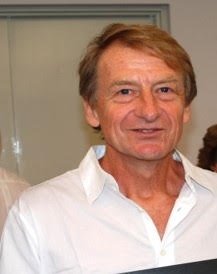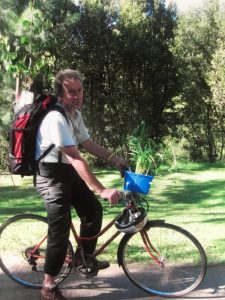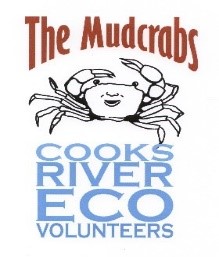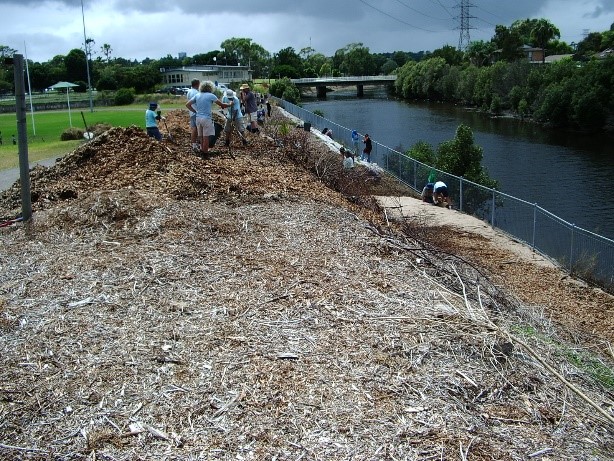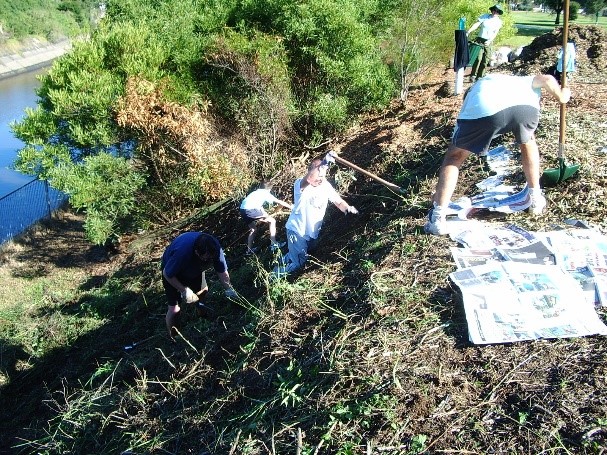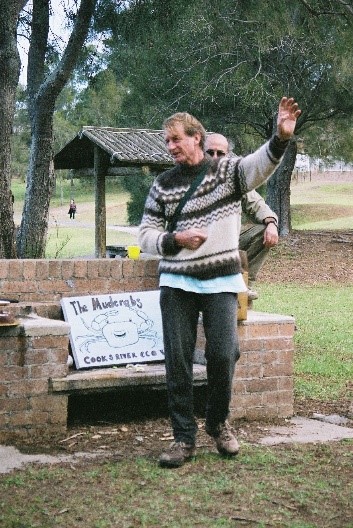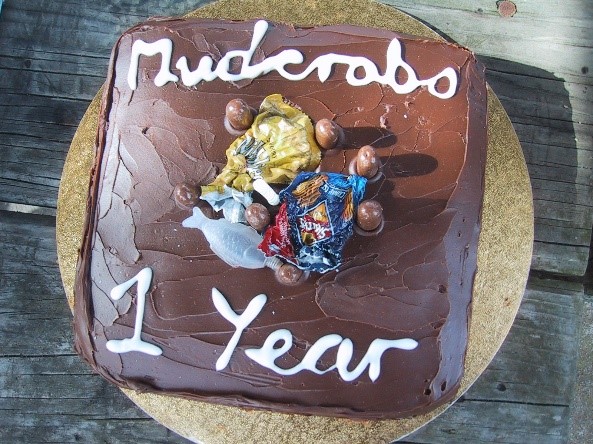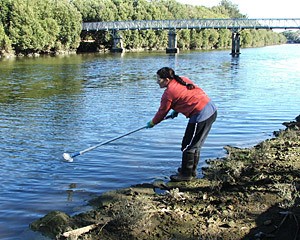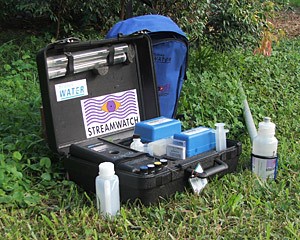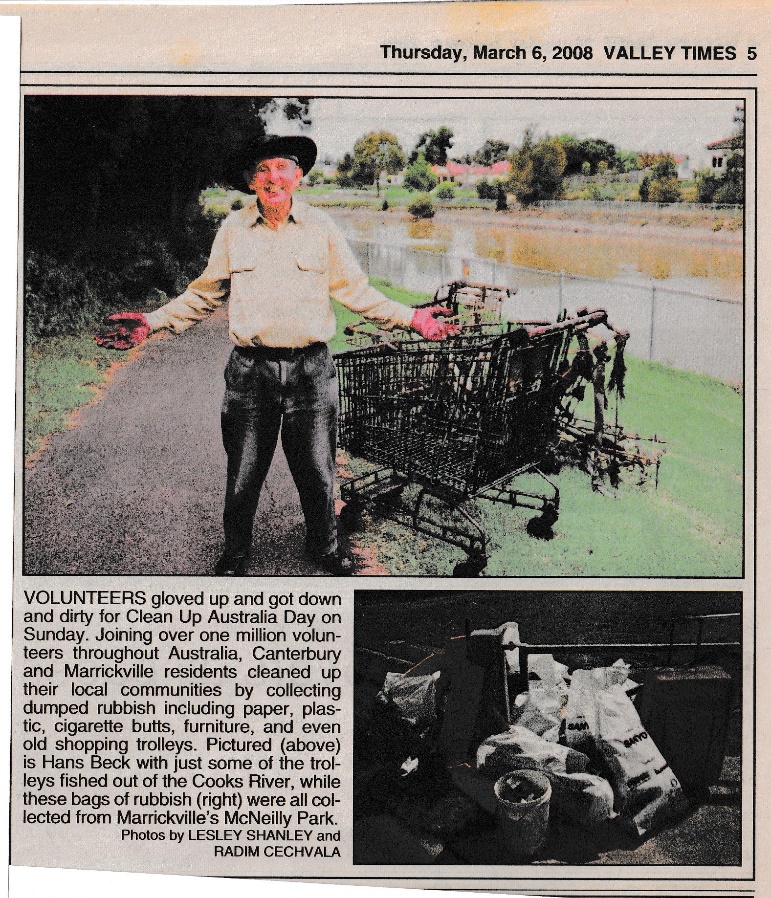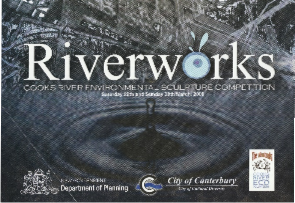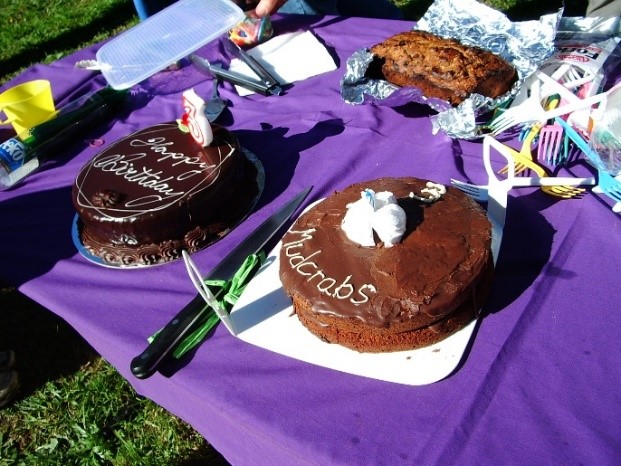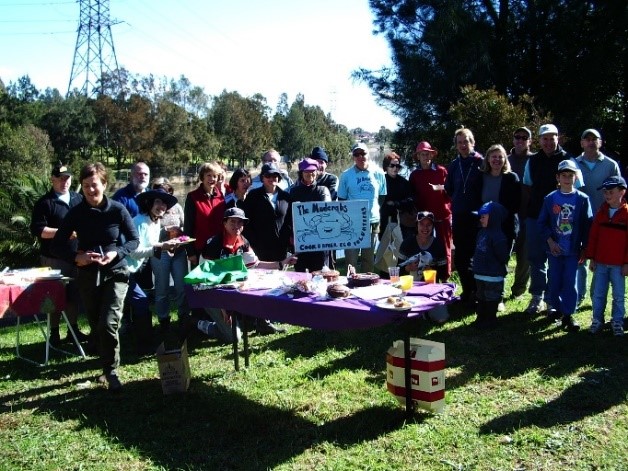IN THE BEGINNING…
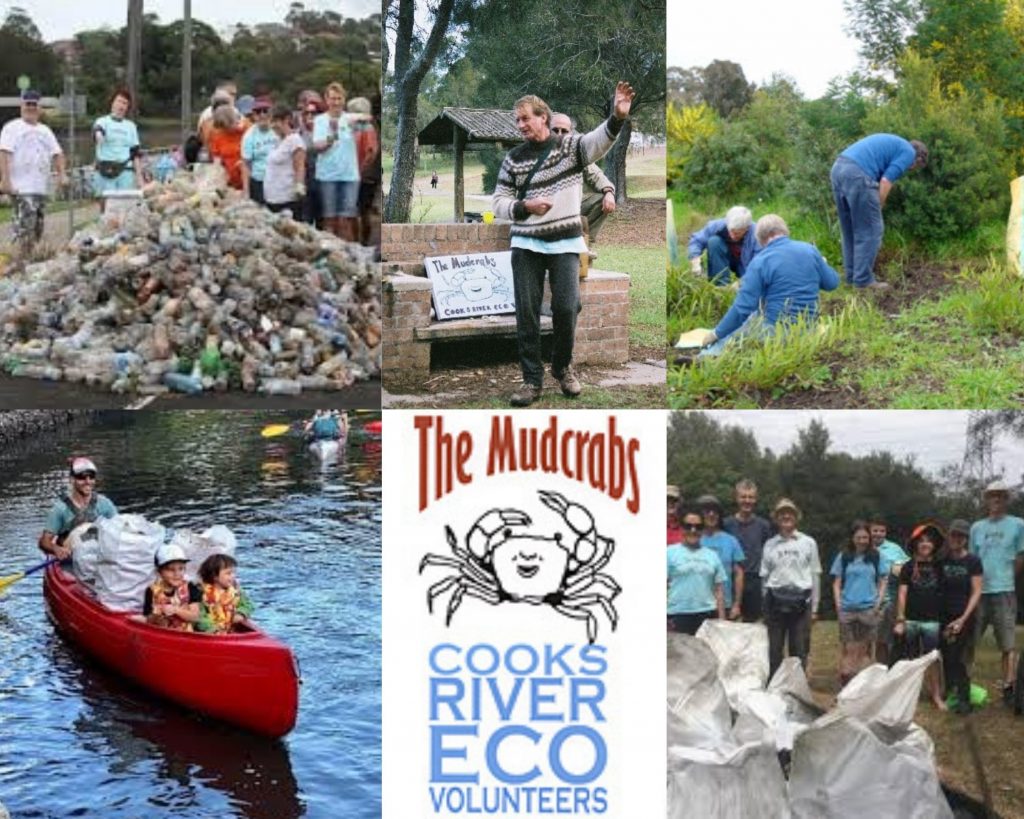
Following is a history of The Mudcrabs.
It is arranged by year and you can jump to specific yearly sections by clicking on one of the following list items.
List of Sections
Mudcrabs 2004 / 2005
2004 – Preamble
The Mudcrabs story begins with Chris Bartlett. Chris Bartlett was an interesting character, whose commitment and determination to be proactive about our environment was both inspiring and contagious. One of Chris’s guiding principles was encapsulated in the sayings “Ready, Fire, Aim” and “Just do it.”
It is understood that Chris Bartlett started and ran an environmental group similar to the Mudcrabs, in Townsville, Queensland in the 1980s, where he was then living. The details of this earlier story are still being researched.
Chris kept meticulous and detailed records of every Mudcrabs event from 2004 until his death in December 2011. This chronology is broadly based on these records kept by Chris. The first entry in these records was on 7.3.04
The story begins
7.3.2004 – the first event recorded by Chris Bartlett, well before the Mudcrabs name came into use, was a clean up on the Cooks River near to Canterbury Racecourse. There were two volunteers listed by Chris Bartlett at this event – himself and Ian Bruce. Together they removed 25 bags of litter. This may have been an unofficial Clean Up Australia Day event. Chris no doubt would have been actively working along the river in the 12 months prior to this 7.3.2004 event, but alas there were no records kept.
Ian Bruce was involved with Chris in many of the early events cleaning up the River and was often spoken of by Chris as a co-founder of the Mudcrabs. Unfortunately Chris and Ian had a disagreement and Ian stopped attending events from late 2005.
Mudcrabs 2005
6.3.2005 – the second event recorded by Chris Bartlett was one year later – Clean Up Australia Day 2005, again at Canterbury Racecourse. This time Chris had registered this as an official Clean Up Oz event and therefore drew many more people to the working bee than the previous event in 2004.
Twelve people attended this 6.3.2005 event and removed more than 40 bags of litter. Twelve people were shown on Chris’s list of attendees :- Glenda…, Ian Bruce, Colin Login, Alison Gibbs, Ian & Louisa Reid & family (four), Hans Beck, Peter Tregillgas, Michele Moss & Chris Bartlett. For the purposes of this chronology, this will be regarded as the first group activity, but the name “Mudcrabs” had not yet come into use.
Chris Bartlett would come to each of these events on his pushbike, carrying all of the equipment needed, including grabbers, bags, gloves, thermos, cups, milk, biscuits etc. At the conclusion of each event, he would push all of this gear back up to his house on the Earlwood escarpment – a very big effort. This was after having phoned each individual the night before, to ask them to attend the event.
30.7.2005 – nearly five months pass before the next event which was at a new site, Boat Harbour, Hurlstone Park. The numbers begin to grow: 20 volunteers – 40 bags of litter removed.
Below is the first poster, prepared by Alison Gibbs and displayed along the river, inviting people to join in this clean-up activity.
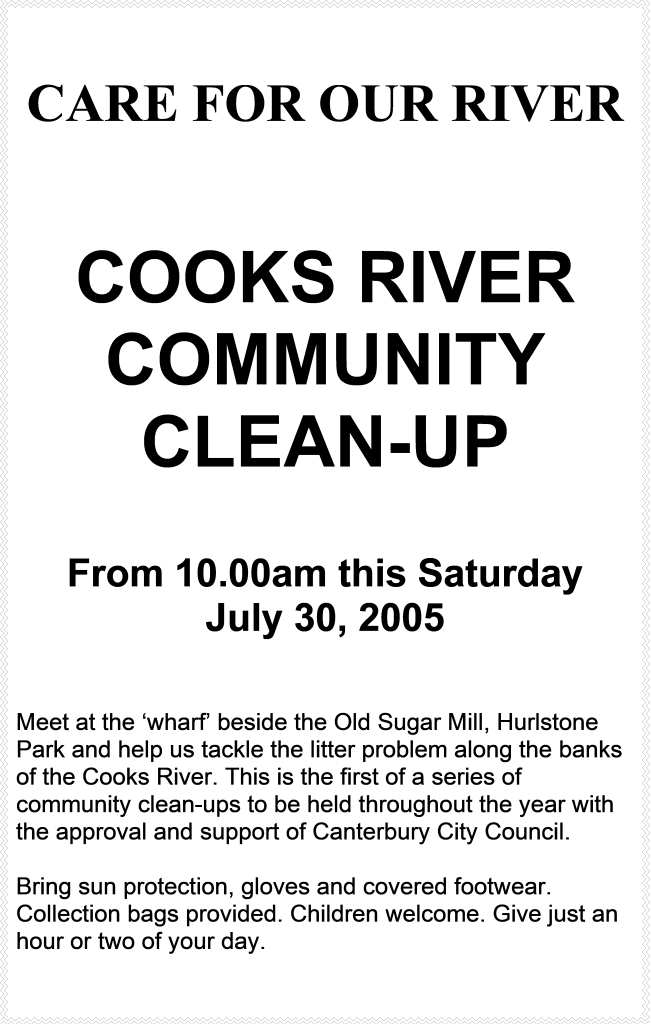
The origin of the Mudcrabs name and logo
In August 2005 Chris Bartlett, Pete Tregilgas, Michele Moss, Fran Munro, Peter Munro, Bronwyn Tuohy & Martin Stanley met to discuss the need for a name for this group, which was now growing quickly and had been working along the River for nearly a year. Following many rejected suggestions for a group name, Fran Munro had a light bulb moment. “As we scurry about on the mudflats at low tide with our pincer like grabbers in our hands, we look a bit like mudcrabs” she said “So why don’t we call the group, The Mudcrabs.” After much discussion “Cooks River Eco-volunteers” was then added as a descriptor.
Chris Bartlett liked the name, adding that the return of real mudcrabs to the river flats would also be an indicator of improved ecological health of the river. (Chris’ positive response to this suggestion may have been linked to his earlier association with mudcrabs in Townsville mentioned above). All those at the meeting agreed and the Mudcrabs name was born.
Michele Moss then designed the current Mudcrabs logo to go with the Mudcrabs name.
Peter T & Michele M successfully sought funding for the purchase of tee shirts from Canterbury Council (David Bell) and had the tee-shirts silkscreened with the Mudcrabs logo. (photo of t-shirt)
27.8.2005 – the group returns to the Boat Harbour site again for litter removal – 20 volunteers, 40 bags of litter removed. Bronwyn Tuohy, a local artist, attended this event. Over the following months, Bronwyn took items of litter that the group removed from the river and incorporated them into environmental sculptures that she would successfully enter into the Sculpture By The Sea events in 2006 and 2007 (see November entry below).
Over the next 3 months, the group met at Little Tasker Park (opposite Canterbury racecourse) on 24.9.2005 (21 volunteers), Rosedale Reserve, Croydon Park on 29.10.2005 (31 volunteers) and back to Boat Harbour on 26.11.2005 (18 volunteers). Over 100 bags of litter were removed from the River at these three events.
Date ??? 2005. Marrickville Council’s Cooks River Festival at Steel Park – Chris Bartlett and several of the regulars had a stall at this event to recruit volunteers for our activities.
20.9.2005 – Email contact with the group begins using Peter Munro’s personal email account. This was to relieve Chris Bartlett of the onerous and time consuming task of individually phoning each of the rapidly expanding number of people the night before an activity to invite them to attend.
29.10.2005 – first recorded working bee at Rosedale Reserve – this was to become the Mudcrabs first and biggest bush regeneration site. Hundreds of hours of work went into this site over the next 18 months, with groups of up to 43 Mudcrabs at a time showing up for working bees. Conservation Volunteers Australia (CVA) workers also assisted us with many hours of work. Chris Bartlett personally recorded 46 separate occasions where he worked alone at the site – Chris was very devoted to the Rosedale site.
November 2005 – Bronwyn Tuohy successfully enters her sculpture, constructed using litter from the Cooks River, into the Sculpture by the Sea Exhibition. This sculpture was entitled “Seaweed.” Bronwyn’s artist statement read: “Rubbish contained in transparent hoses, funnelled from the human giant ever outwards – evolving into the new nature. Like introduced species, foam and plastic roam free – seemingly reproducing itself“
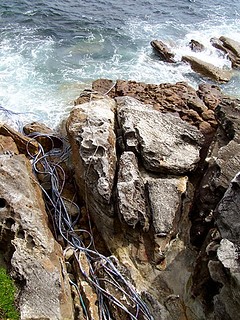
In total, the Mudcrabs ran six events in 2005, with 110 volunteers (220 hours) removing 230 bags of litter from the River.
The group was beginning to develop a strong identity. In just over one year the Mudcrabs had developed into a vibrant, active and productive community group with an amazing list of achievements that would transform the Cooks River over two decades.
Mudcrabs 2006
The number of people attending Mudcrabs events really started to grow in 2006, with a combined 67 volunteers attending the January (28th) and February (18th) clean ups at Rosedale Reserve and Boat Harbour respectively, where over 80 bags of litter were removed from the River.
The new Mudcrabs t-shirt were given to everyone who attended. This proved to be a very successful strategy to draw attention to the group and its activities, as the distinctive blue shirt with the iconic Mudcrabs logo stood out and drew attention to the group as they worked on the River.
5.3.2006 – Clean Up Australia Day – this increasing community interest in Mudcrabs events continued with another 40 volunteers participating in this CUA event. Over 170 bags of litter were removed from Boat Harbour and Canterbury racecourse sites on the day – what a massive effort!
26.3.2006 – Bronwyn Tuohy’s successful entry in the 2005 Sculpture by the Sea was the inspiration to conduct our own environmental sculpture competition on the Cooks River. This was titled RiverWorks – Cooks River environmental sculpture competition and was held at Gough Whitlam Park, Tempe. This event was many months in the planning by the hardworking team of Chris Bartlett, Martin Stanley, Peter Tregilgas, Michele Moss, Bronwyn Touhy, Fran Munro & Peter Munro.


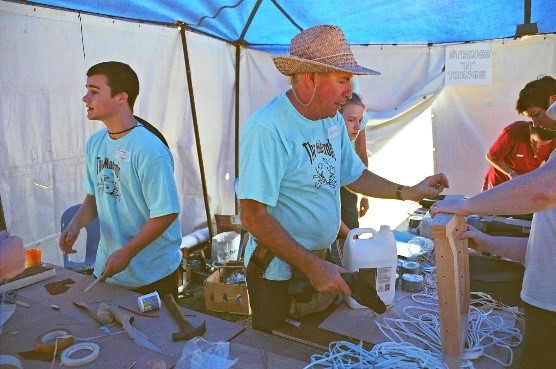
Bronwyn Tuohy successfully applied for funding for the Riverworks event from Suez waste company and prize money was offered for the winning sculptures. Constructed works had to reflect the Cooks River. Material and waste items were sourced from Reverse Garbage. This was a hugely successful event with over 220 entries.
The Marrickville Historical Society newsletter of April 2006 is quoted below:
“The Society was among a range of environmental and heritage groups to have a stall at the Riverworks Cooks River Environmental Sculpture Competition at Gough Whitlam Park, Undercliffe on Sunday 26 March. The competition was conducted by environmental group, the Mud Crabs in conjunction with Canterbury Council. The organisers see environmental sculpture as a good way to present solutions to environmental problems. The Mud Crabs undertake monthly clean ups along Cooks River usually on the first Saturday of each month. Volunteers are welcome to call Chris Bartlett.”
6.5.2006 – Clean up sites expanded to include Marrickville Golf Course, along the River’s edge adjacent to the 17th fairway, with 32 volunteers removing 80 bags of litter
4.6.2006 – Mudcrabs first birthday celebration BBQ – Earlwood, opposite Marrickville golf course. This celebration was held following a huge clean up where 43 volunteers worked both sides of the River removing 160 bags of litter. The group met up with the day release prisoners who were also removing rubbish from the River’s edge – they even joined us for the BBQ.
Chris Bartlett giving the 1st birthday speech and the celebration cake (notice litter decorations by Alison Gibbs)
1.7.2006 – Ian Kiernan , founder of Clean Up Australia, joined us for our July clean up at Boat Harbour. Ian would continue to show a keen interest in the work of the Mudcrabs and became our official patron.
Sept 2006 – first discussions between Wolli Creek Preservation Society, Cooks river valley Association and Mudcrabs about the prospect of a formal Two Valley Trail walking circuit being created through the Cooks River valley and Wolli Creek valley.
CRVA agrees (in principal) to purchase a small motorised boat to assist the Mudcrabs with their river clean-up activities. Concept proposed by Peter Tregillgas.
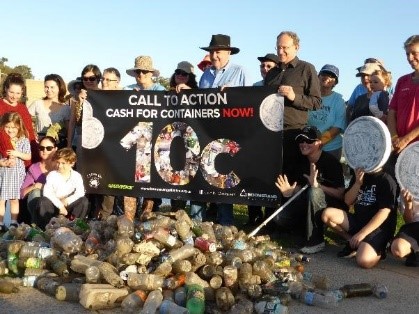
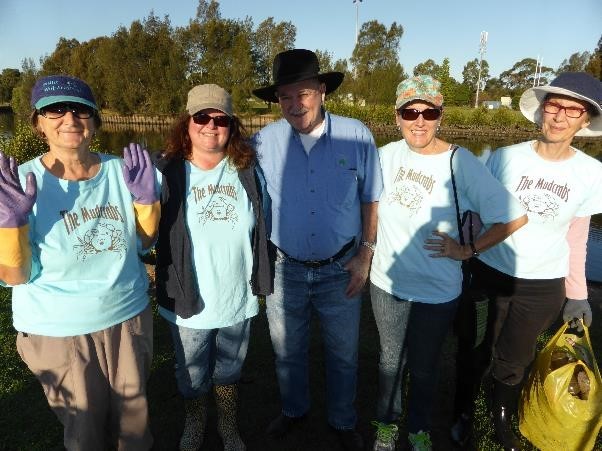
Nov 2006 – Bronwyn Tuohy exhibits a second work in the Sculpture By The Sea called “Aftermath”, again featuring items of rubbish removed from the river. This sculpture consisted of several clear perspex cannons, filled with litter from the Cooks River and positioned on Tamarama Beach.
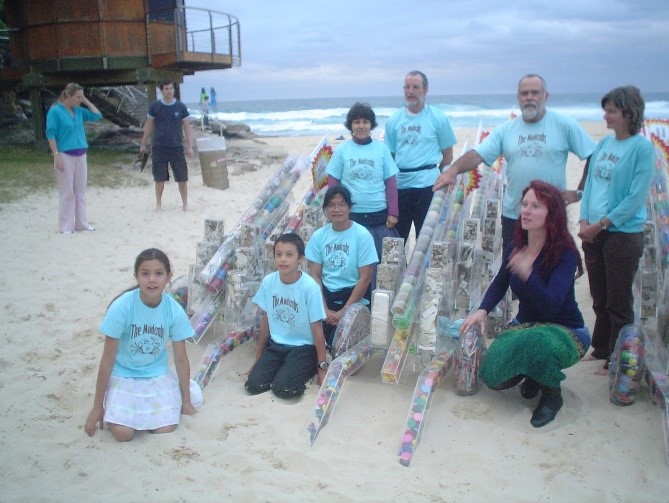
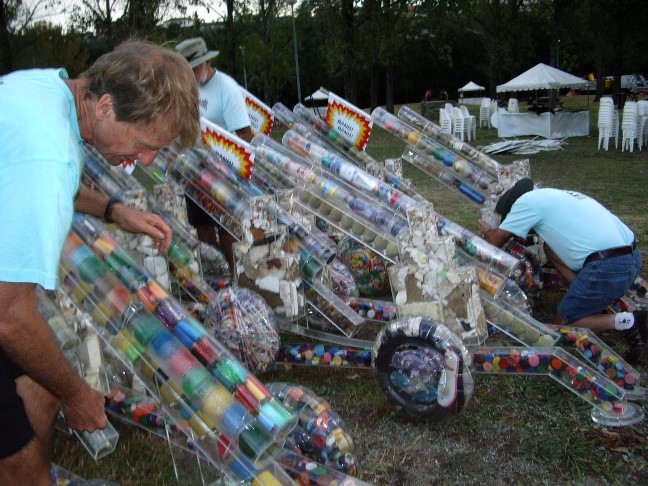
Aftermath – Bronwyn Tuohy’s entry into the 2006 Sculpture By the Sea competition. Exhibit was positioned on Tamarama Beach (Bronwyn squatting in the foreground of the upper picture)
In 2006 the Mudcrabs ran 10 clean-up events along the River, with 358 volunteers (720 volunteer hours) removing over 600 bags of litter from the River. In two short years the Mudcrabs had contributed more than 1,000 hours of volunteers time working on the Cooks River and removed nearly 900 bags of litter. What an effort!!
Mudcrabs 2007
During 2007 clean up sites were expanded to include Kendrick Park, Tempe & Holebeach Ave, Tempe (28.5.07) and bush regeneration sites expanded to include Foord Ave Hurlstone Park (1.12.07),
7.2.2007 – Mudcrabs planning meeting. Bronwyn Tuohy raised the need for a state-wide container deposit scheme to combat the vast number of plastic containers that were finding their way into the River. This is the first recorded mention of the campaign that would become one of the Mudcrab/CRVA’s most successful campaigns.
24.2.2007 – The Cooks River Valley Association held a community forum at Canterbury/Hurlstone Park RSL Club which many Mudcrabs attended. This was an early indicator of the converging interests of the CRVA and Mudcrabs.
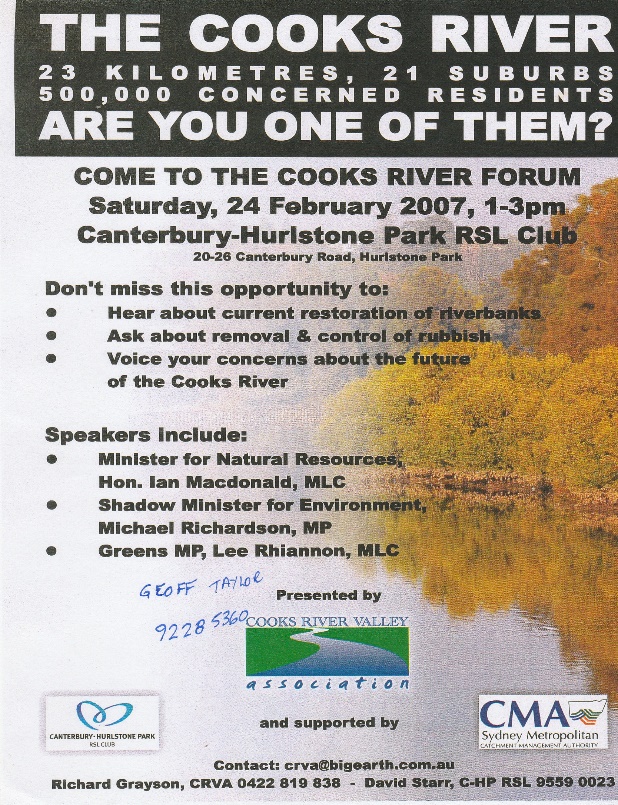
4.3.2007 – Clean Up Oz was a very big day for the Mudcrabs, who partnered with Canterbury/Hurlstone Park RSL Club to run a major event attracting over 90 volunteers (including Linda Burney, MP for Canterbury). The Mudcrabs cleaned up multiple sites along the River on this big day, removing hundreds of bags of litter. This was a huge event with logistic support from CHPRSL who provided a bus to move people around the many clean-up sites and a BBQ at Ewen Park for all participants afterwards.
March 2007 –the second Riverworks Environmental Sculpture Competition was again run at Gough Whitlam Park. This event was even bigger and more successful than the 2006 event.
15.4.2007 – Mudcrabs had a stall at Marrickville Council’s Cooks River Sustainability and Arts Festival held at Steel Park, Marrickville. The group provided information on Mudcrabs activities, concerns about the River health and recruited many interested community members.
21.4.2007 – Canterbury racecourse clean up – 60 volunteers. 75 bags of litter
In total the Mudcrabs ran 10 clean-up events and 3 bush regeneration events in 2007, with 342 volunteers removing 587 bags of litter and 72 volunteers weeded and planted 3 bushcare sites, a total of 826 volunteer hours for the year.
Meanwhile the Mudcrabs were getting involved in another interesting program involving testing the water quality of the Cooks River. This program was set up in November 2007 by Gayle Adams (Mudcrab & member of the CRVA).
The account below was written by Gayle.
Water Quality Testing in the Cooks River
Many Mudcrabs were also members of the Cooks River Valley Association. One of CRVA’s key objectives was to improve the health of the Cooks River, including its water quality, the state of the riverbed and its flora and fauna. Walking along the river one might have seen oil slicks or floating rubbish but it was really hard to tell how much oxygen or phosphate the river contains or whether it is polluted with faecal matter.
In November 2007, Gayle Adams, formed a small group of volunteers to take measurements of critical water quality factors. The formation of the group was supported by the Cooks River Valley Association.
Training and test equipment were provided through Australian Museum’s Streamwatch Program http://www.streamwatch.org.au/streamwatch/
Where did they test and what did they find?
Volunteers took water samples from the Cooks river at Ewen Park, Younger Avenue, Steel Park, Marrickville Golf Course and River Canoe Club near Tempe. Volunteers could be seen on the riverbank with bottles and pole dipping into the water to collect a sample, then back to the portable laboratory for testing.
Results were compared with Government guidelines [viz. Australian and New Zealand Guidelines for Fresh and Marine Water Quality ANZECC 2000]. For example, the healthy guideline range for dissolved oxygen [expressed as a percentage of the saturated value at a given temperature] is 85-110%. Results were often outside this range. Faecal coliform values were highly variable and depended partly on weather and sewerage performance. Results frequently exceed secondary human contact levels [ie maximum for boating and fishing 1000 CFU/100ml].
What was done with the data?
Results from over 70 testing sessions were submitted to Sydney Water for publication on the Streamwatch website.
The data was also used for :
– Preparing trend analyses to identify improvements in water quality at individual sites
– Reporting to Councils
– Notifying pollution events to Councils, DECC and Sydney Water
Quality Assurance
The group became members of Australian Museum’s Streamwatch Program and used Streamwatch methodology and equipment, participating in annual quality assurance events. In 2008 the water quality group won the Streamwatch Award for Outstanding Community Group.
At about the same time, Gayle Adams started a pollution reporting process encouraging people to keep an eye out for pollution by becoming a ‘Cooks Eye’.
Keeping a ‘Cooks Eye’ on the River – Report Pollution
Cooks Eye – a citizens pollution reporting process. People who visit the river regularly may noticed unusual things – a really bad odour or an oil slick or a large frothy scum or an unusual discharge from a drain or even a dead fish or two. Regular users of the river kept us up to date with what was happening. For example, in November 2008 we received dozens of reports from people walking and canoeing at the Cooks, of hundreds of dead fish in the river. As a result we were able to follow up with relevant agencies to identify the stormwater drain that discharged the toxic waste responsible for the fish kill. We then monitored that drain regularly.
We asked people to report observations first to the relevant agency. Often this was the local Council. And then to notify us so we can follow up to ensure action has been taken.
What’s in the Cooks River?
- Tidal seawater, river water, stormwater runoff, rainwater
- Fish, worms, mussels, crabs, microorganisms
- Aquatic plants and algae
- Sediments on the river bed contain heavy metals like lead, zinc and arsenic.
- And after heavy rain or sewer chokes … sewage from sewerage overflows
What did Streamwatch test and why did we test it?
| What | Why |
| Temperature | The temperature of the water has a major effect on biological activity and growth of river organisms. |
| pH | This tells us how acidic or alkaline the water is. Freshwater fish and other river life are sensitive to changes in pH. Extremely high or low pH levels will lead to the death of aquatic life. |
| Electrical conductivity | This tells us how much salt and organic acid is in the water. Freshwater organisms cannot live in very salty water. |
| Turbidity | This tells us how cloudy or muddy the water is. Turbid water reduces the amount of light entering the river environment. Plant growth decreases and this impacts on the animals that rely on the plants [for food, shelter, oxygen]. |
| Dissolved oxygen | Dissolved oxygen is essential for fish, worms, etc living in the river. Fish die if there is not enough dissolved oxygen in the water and they get environmentally ‘stressed’ if the levels are low. This means they are more susceptible to disease, etc. |
| Available phosphate | Phosphorus [in phosphates] is a nutrient essential to the growth of plants and animals. The available phosphate test tells us how much soluble phosphate there is available to plants. Too much phosphate leads to an abundance of algae and aquatic weeds. And less oxygen for fish. |
| Faecal coliforms | These are naturally occurring bacteria found in the intestines of all warm blooded animals including humans. If we find faecal coliforms in the river it generally means the river has been contaminated by human sewage. |
What results did we get?
Here are some highlights from our 2008/09 report based on 46 test sessions at 5 Cooks River sites.
– Water quality in the Cooks River is relatively poor
– On 50% or more of the tests we found:
. low dissolved Oxygen [below 85% saturation]
. high available Phosphate [above 0.0612 mg/L]
. high faecal counts [above 150 CFU/100mL primary contact level]
– Results for pH and turbidity were generally within guidelines
– Tests for faecal coliforms and E. coli done at all sites (except Richardson Crescent). We compared median results with the guidelines for primary and secondary human contact i.e. for swimming and for boating.
The levels are:
. above primary contact at all sites except Younger Avenue (downstream) and in the stormwater drain itself.
. above the secondary guideline at Ewen Park
. the highest recorded result was 20,400 CFU/100mL at Younger Avenue (upstream). This is 20 times the secondary contact guideline.
Gayle went on to be made a Life Member of the Cooks river valley Association in recognition of her tireless work on the River.
Mudcrabs 2008
The joining of forces…
In 2008 the Mudcrabs formally became affiliated with the Cooks River Valley Association (CRVA), an incorporated community association with a long history of advocacy for the Cooks River. This proved to be a very successful affiliation, with the Mudcrabs becoming the “action arm” of the CRVA, with many Mudcrabs elected to the Committee of the CRVA.
The CRVA developed a much higher profile when joined with the expanding and action focused Mudcrabs group. At the same time the Friends of Ewen Park also affiliated with the CRVA, expanding even further, the scope and reach of these combined community groups. (See a brief history of the Friends of Ewen Park later in this chronology).
Much of the history of the Mudcrabs, Friends of Ewen Park and the CRVA become closely associated through these affiliations, with the majority of members of the CRVA also being active Mudcrabs and members of the Friends of Ewen Park.
This chronology of the Mudcrabs now becomes a shared chronology of the CRVA & Friends of Ewen Park from this time forward.
2.3.2008 – Clean Up Oz – another big day for the Mudcrabs with 37 volunteers removing 194 bags of litter from the River.
29 & 30.3.2008 – The 3rd Cooks River Riverworks Environmental Sculpture Competition. This very successful event was held for a third year over a weekend. The scale of the event and the complexities of organisation would prove to be very demanding, resulting in this being the last Riverworks event to be held.
April 2008 – The Cooks River Valley Assoc, The Mudcrabs and the Wolli Creek Preservation Society join together to run the Two Valley Trail Photographic Exhibition. The event was to herald the opening of the opening of the Two Valley Trail – a 12 kilometre walk through both the Cooks River Valley and the Wolli Creek Valley. The Governor of NSW, Professor Marie Bashir, formerly opened the exhibition at Canterbury Library and commented “This superb photographic exhibition gives us a wonderful introduction to a uniquely beautiful area of Australian bush. My congratulations and appreciation to all involved in this project.”
It was an outstanding exhibition, highlighting the rarely acknowledged natural treasures of our two valleys.
11.5.2008 – Cooks River Valley Garden, Tempe Reserve added to The Mudcrabs bush regeneration sites
7.6.2008 – Mudcrabs in conjunction with Sydney Water took 26 Mudcrabs volunteers on a tour of the newly constructed Chullora Wetlands & Chain of Ponds wetlands. These wetlands are a classic examples of reclaimed industrial land successfully converted to fully functioning wetlands and demonstrated that major improvements to the Cooks River could be achieved when there was the political will.
11.7.2008 – First inspection of Foord Ave, Hurlstone Park as a potential bush regeneration site. The site was identified in Doug Benson’s book “Missing Jigsaw Pieces – The Bushplants of the Cooks River Valley.” It would be another 11 months (13.6.2009) before the first formal working bee took place with Liz Millen as site co-ordinator.
Leading up to this working bee, there were letterbox drops to all local residents, community meetings on site to outline plans for the site and removal of camphor laurel trees. This is the only bush regeneration site where such a long and involved official process was imposed on The Mudcrabs in creating new bushcare sites.
26.7.2008 – Mudcrabs 3rd birthday celebration at Canterbury Racecourse site (41 volunteers, 90 bags litter removed)
1.11.2008 – Cooks River Forum – theme “Showcasing & Celebrating the Cooks River”
This Forum brought together many groups & Govt agencies that were working on projects to improve the River, including Canterbury, Marrickville and Strathfield Councils, Sydney Metro Catchment Authority, Cooks River Foreshore Working Group and the Cooks River Sustainability Initiative. The Forum was held at Mytilian House, Canterbury. The theme was for all groups and agencies to showcase their projects on the Cooks river. The Forum was very well attended and deemed a huge success.
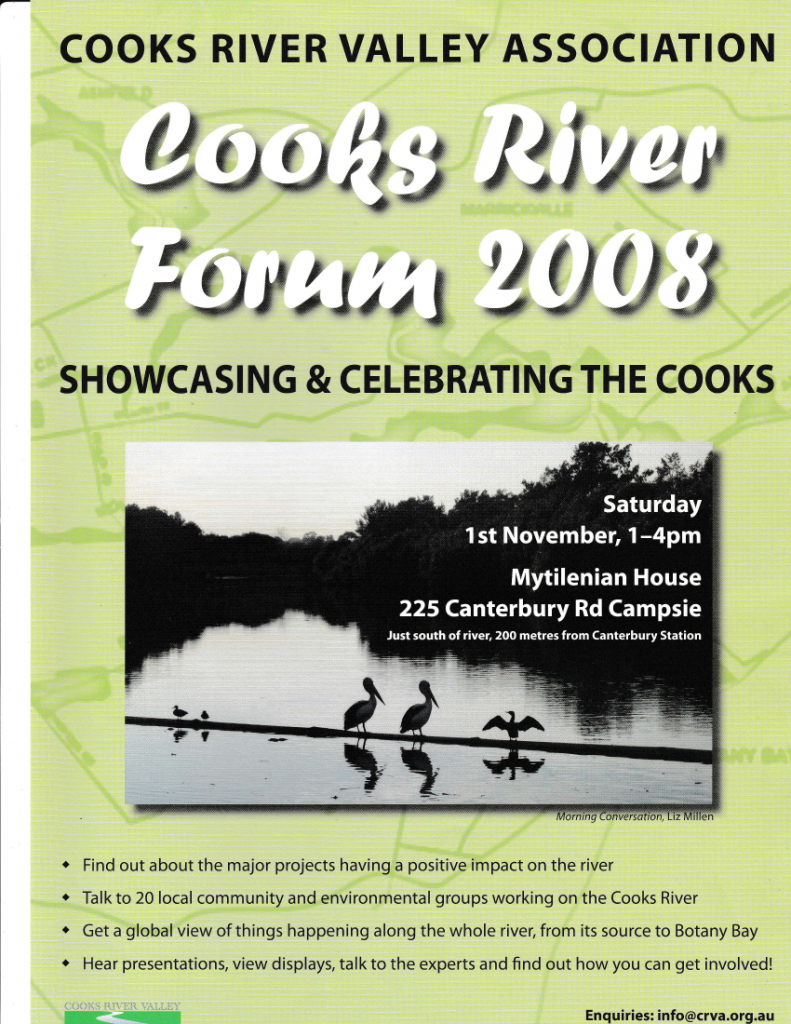
November 2008 – funding for The Cooks River Urban Water Initiative was confirmed by Anthony Albanese (MP for Grayndler). This Urban Water Initiative would prove to be the most successful ecological major works projects to be completed in the Cooks River catchment.
In 2008 Mudcrabs ran six clean up activities (280 volunteers – 560 hours), removed 551 bags of litter and 18 shopping trolleys from the River. They also ran eight bush regeneration activities with 157 volunteers (314 hours). A total of 874 volunteer hours for the year.
After only four years the Mudcrabs had volunteered over 2,640 hours and removed more than 2,000 bags of litter from the Cooks River and were beginning the major task of revegetation of the riparian zones along the Cooks River.
TO BE CONTINUED!

